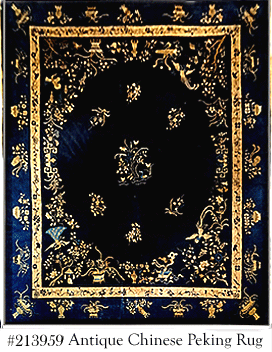Antique Oriental Chinese Rugs
Overview
The centuries-old Chinese textile industry is rich in history - Chinese carpets were first woven centuries ago by nomadic tribes in the Xinjiang [Sinkiang] and Ningxia [Ninghsia] regions of western China - but it wasn't until sometime towards the start of the 20th century that the making of rugs for export to the west began in earnest as the quality and fineness of the rugs was improved to satisfy market demands.
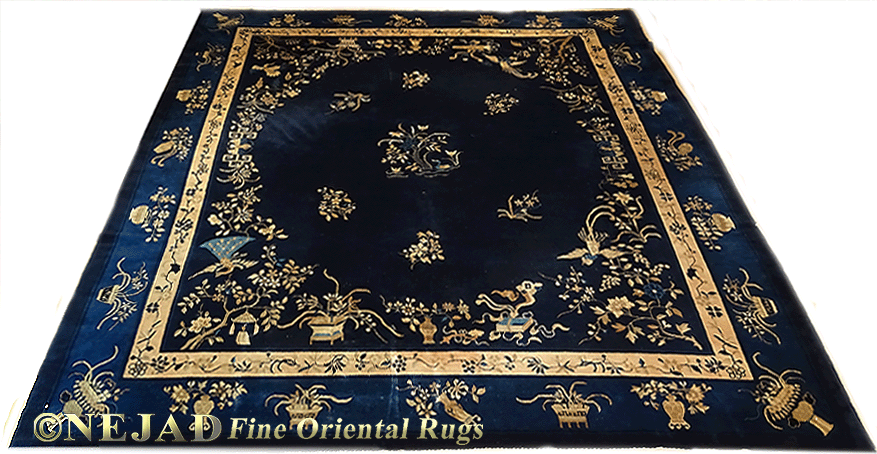
Nejad's impressive 10' 10" × 11' 7"
antique Chinese Peking oriental rug c. 1900 in classical black & gold
- catalog #213959.
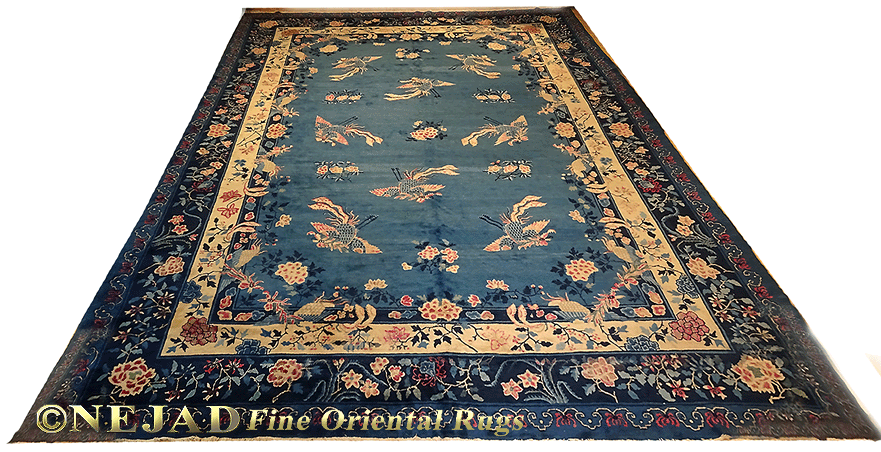
Another impressive 10' 2" × 13' 5"
antique Chinese Peking oriental rug c. 1900 in classic navy & ivory
- Nejad catalog #22195.
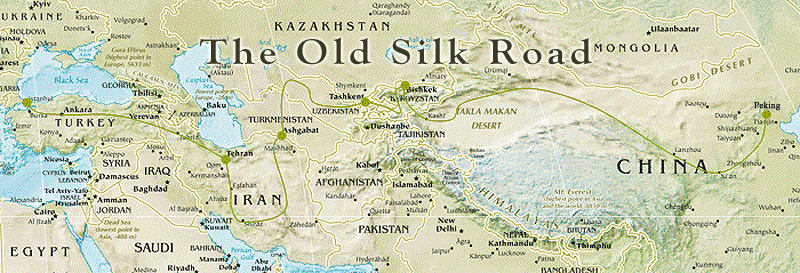
The Antique Peking Rug
Using weaving techniques very much like those of Persia, India and Central Asia, Chinese (Peking) rugs were constructed primarily of sheep's wool hand-knotted on vertical looms. Some rugs were woven entirely of silk or had silk pile while a lesser number used goat or camel hair. With regards to construction: Persian knots were typically used for the field of the rug while the Turkish knot was occassionally used for the rug border. Though the knot density of the typical 19th century Chinese carpets may not have been particularly fine (30 - 60 KPSI), the pile itself was relatively long and the knots twisted so loosely that the ends opened and spread into tufts - thus giving the finished rug a denser, finer surface appearance. And by the 20th century, the knot density on Chinese rugs for export had undergone an overall improvement to approximately 100 knots per square inch (KPSI).

Christie's
- www.christies.com - lot #4161114
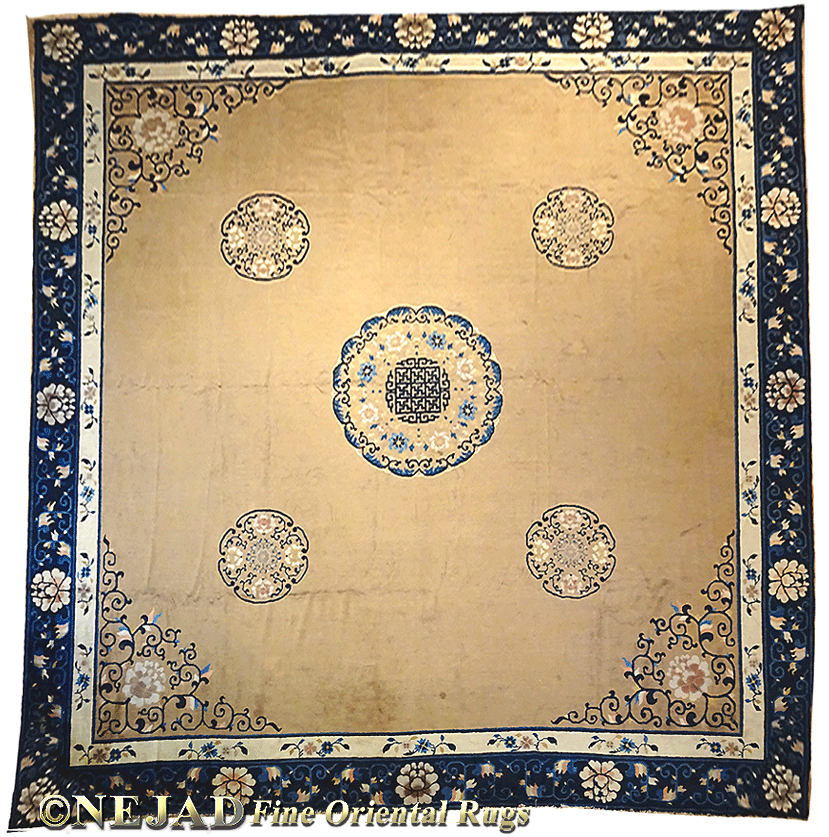
This 13' 6" × 14' 3" Antique Chinese Peking Carpet c. 1900 is now
being offered by Nejad - Catalog #22269
The coloring of Chinese rugs is quite unlike that of western carpets - typically employing a limited palette consisting of as few as two colors and featuring a predominantly solid color field of either royal blue, yellow, light blue, apricot or even black. Surface designs were sometimes enhanced by incising the motif so the that rug detail was in relief - adding a 3-D effect. Some of the popular motifs used included dragons, lotus flowers and elaborate octagonal or knot of destiny figures (see chart below).

Peking design motifs include the circular
geometric Shou, dragons, lotus flowers as well as elaborate octagonal medallions.
Chinese Art Deco Rugs
Influenced by western tastes and enterpreneurial western rug manufacturers in China, it might be said that the Art Deco influence on Chinese rug manufacturing was more a commercially-motivated influence than it was any type of intellectual or otherwise artistically inspired development. As a logical outgrowth of the industrial progress of the 20th century and increase in commercialization and consumerism, the Art Deco design - or designer - trend was in full swing by the end of WWI and flourished from the 1920's to the 1930's. These rugs feature a less symmetrical, more free-form and innovative approach than traditional - often 2-color - Chinese themes. Elaborate and exotic pictorial scenes are rendered in bold, vibant colors featuring flowers, trees, birds, vases and dragons - the pile often incorporating silk highlights.
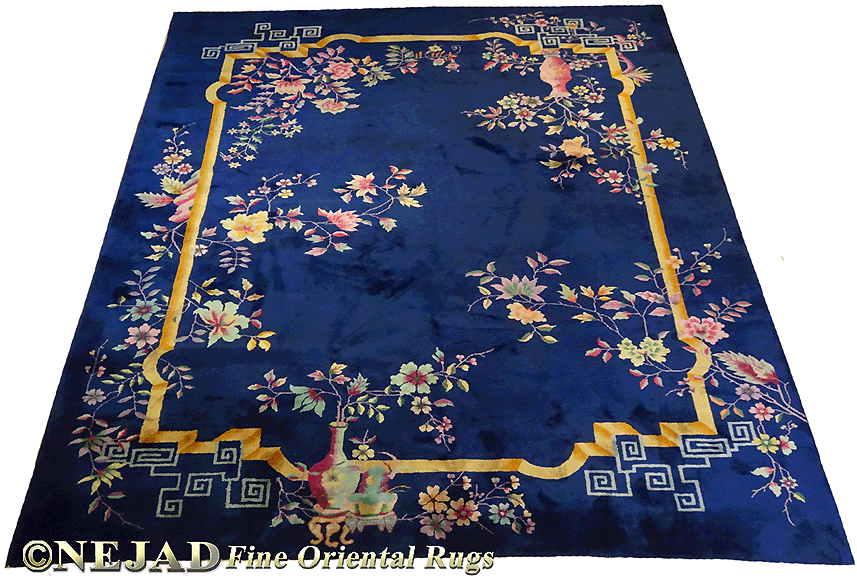
A 'full-pile condition' 8' 9" × 11' 6" antique Chinese Art
Deco rug c. 1920 is now offered by Nejad - catalog #24613.
Rug Production in China
Some of the earliest surviving examples of the art of hand woven carpetry in China were known to be produced from 557 - 589 AD during the Chen Dynasty - also known as the Southern Chen dynasty. Typically, antique Chinese carpets can be classified according to the ruling dynasty in power at the time of their production (or to their place of origin). By the early to mid-19th century, carpet production flourished at the Imperial Court of Beijing (Peking). Particularly instrumental in this progressive development of the state of the art form was the patronage of three emperors of the Ching [Ch'ing] Dynasty (1644-1912) - Chien Lung, Chia Ching, and Tao Kuang.
Rugs produced in China - or, more specifically, rugs incorporating Chinese design particularly - first gained "official" recognition in America via the 1903 Saint Louis International Exhibition when a Chinese rug was awarded first prize. With media visibility and western interest kindled, substantial efforts were made to transform a cottage handicraft into a major industry in, most-notably, the Beijing and Tianjin areas of northeastern China. By the 1920's, so-called Peking-style [Beijing] and Tiensin-style [Tianjin] rugs were modified and produced according to American import specifications with a requisite increase in popularity and sales in the US market.
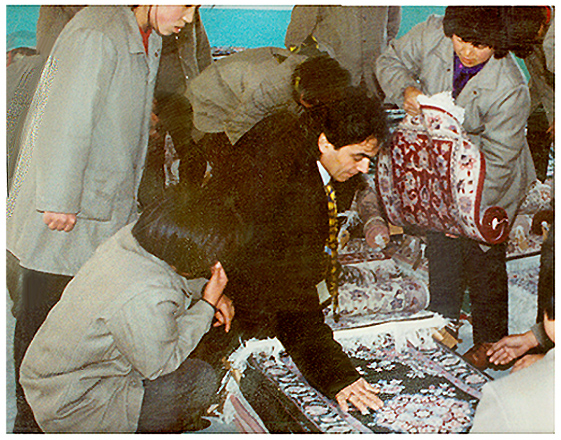
Mr.
Ali Nejad, founder and President of Nejad Rugs of Doylestown, PA,
inspects a rug in Tianjin, China (above - center).
Consumer Notes
Owing to the great diversity of themes and figures used, as well as the lack of standardization, old rugs produced in China are among the most unique and/or original rugs found anywhere. China offers the consumer one of the broadest varieties of design styles as well as a variety of construction types such as pile, kilim, and needlepoint.
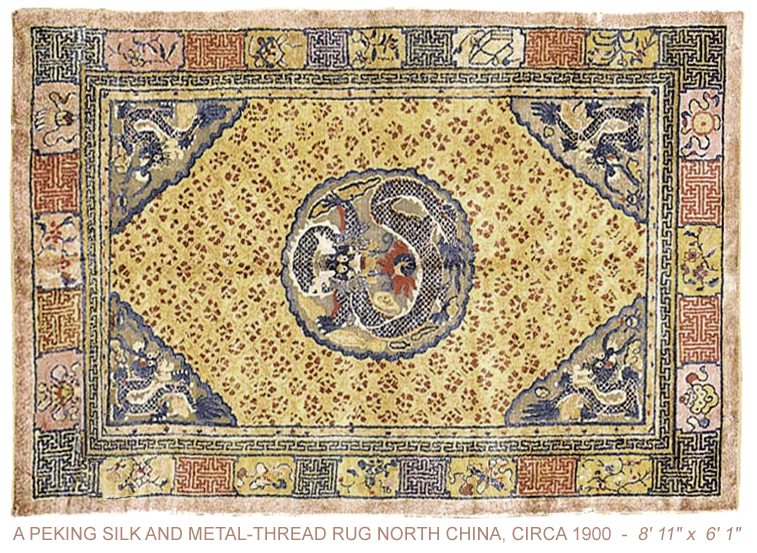
Christie's
- www.christies.com - lot #4161114
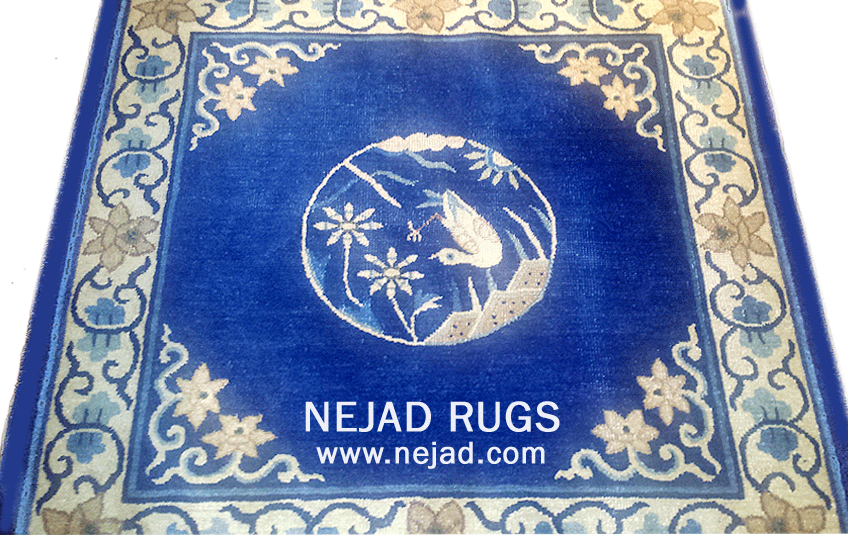
Nejad's exquisite antique Chinese Peking oriental
rug Circa 1900 in classic blue Nejad #24319 ( Size: 2' 9" × 3' 5" ).
Currently Nejad is offering the following antique Chinese carpets for sale:
About:
Tabriz Antique Rugs | Heriz Antique Rugs | Mashhad Antique Rugs | Sarouk Antique Rugs | Kashan Antique Rugs
Kerman Antique Rugs | Serapi Antique Rugs | Bidjar Antique Rugs | Karabagh Antique Rugs | Senneh Antique Rugs
Bakhtiari & Antique Bakhtiari Rugs | Nain and Antique Nain Persian Rugs | Ziegler Mahal Antique Persian Rugs
Esfahan & Antique Esfahan Rugs | Qum Antique Rugs | Farahan Antique Rugs | Darjazin-Hamadan Antique Rugs
Hereke Antique Rugs | Akstafa Antique Rugs | Antique Gharajeh Rugs | Chichi Antique Rugs | Mudjar Antique Rugs
Kazak Antique Rugs | Shirvan Antique Rugs | Beluch Antique Rugs | Peking Antique Rugs | Kurdish Antique Rugs
Turkeman Antique Rugs | Dagestan Antique Rugs | Flemish Antique Tapestry | Antique Ming Chinese Rugs
French Aubusson Antique Tapestry
- after Francois Boucher

